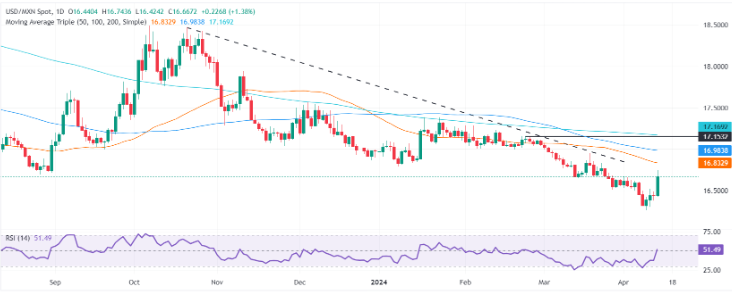- The Mexican Peso is encountering a significant downturn amid escalating geopolitical tensions and cautious sentiments fueled by hawkish remarks from Boston Fed’s Susan Collins.
- Concerns over a potential Iranian attack on Israel are prompting investors to seek refuge in safe-haven assets.
- Additionally, Susan Collins’ revision of rate cut expectations indicates a prudent stance towards monetary easing, further influencing market sentiment.
On Friday, the Mexican Peso experiences a sharp decline against the US Dollar, driven by a risk-off sentiment fueled by speculation surrounding a potential Iranian attack on Israel over the weekend. Additionally, surprisingly hawkish remarks from Boston Federal Reserve President Susan Collins contribute to the downturn, impacting the emerging market currency and potentially leading to weekly losses. The USD/MXN pair trades at 16.68, having reached a daily low of 16.40, reflecting a 1.50% increase.
US equities are witnessing a decline as market sentiment deteriorates. Reports from CBS News indicate Israel’s preparedness for a potential direct attack from Iran in retaliation for a recent strike that resulted in the death of seven Iranian military officers.
Furthermore, Susan Collins of the Boston Fed suggests that, given the latest inflation data, she anticipates the Federal Reserve (Fed) to delay its initial rate cut compared to previous expectations. She also mentions a projection of two rate cuts for the year, contrary to the three projected in the Federal Open Market Committee (FOMC) Summary of Economic Projections (SEP).
Daily digest market movers: Mexican Peso falls on risk aversion
- According to CBS News, two US officials indicated that a significant Iranian attack on Israel was anticipated as early as Friday, potentially involving over 100 drones and numerous missiles targeting military installations within the country.
- Meanwhile, the University of Michigan’s preliminary April Consumer Sentiment index declined to 77.9, falling short of the anticipated 79.0. Inflation expectations for the upcoming year rose to 3.1% from previous forecasts and a prior reading of 2.9%. Over a five-year period, expectations increased from 2.8% to 3.0%.
- In Mexico, economic data releases were limited on Friday, although significant information emerged earlier in the week. On Tuesday, Mexico’s Consumer Price Index (CPI) continued its trend of disinflation, with both overall and core CPI decelerating on a monthly and yearly basis. This aligns with the Bank of Mexico’s (Banxico) decision to lower interest rates on March 21, despite the yearly CPI slightly surpassing expectations.
- Additionally, on Thursday, Mexico’s Industrial Production contracted by 0.1% month-on-month in February, falling short of the anticipated 0.3% growth. However, it registered a 3.3% increase over the twelve-month period ending in February, narrowly missing forecasts.
- Across the border, the United States released inflation data. Wednesday’s Consumer Price Index (CPI) figures showed higher-than-expected inflation, while the core CPI, excluding food and energy, remained stable compared to February. On Thursday, the Producer Price Index (PPI), representing prices paid by producers, declined both monthly and annually from the previous month.
- Moreover, initial jobless claims for the week ending April 6 were 211,000, below the expected 215,000 and the previous week’s 222,000.
- Considering this data, along with Wednesday’s inflation report revealing a 0.4% monthly increase in CPI and a 3.5% yearly rise, traders are anticipating two rate cuts by the Federal Reserve in 2024. Data from the Chicago Board of Trade suggests that the fed funds rate is projected to conclude the year at 4.92%.
Technical analysis: Mexican Peso succumbs to the Greenback, USD/MXN rallies toward 16.60s

Despite a recent uptick towards the 16.70 level, the USD/MXN pair maintains a downward bias. While buyers have pushed the exchange rate higher, reclaiming the 50-day Simple Moving Average (SMA) at 16.82 is essential to potentially challenge the 17.00 level. Subsequently, breaking above these levels could lead to a test of the 200-day SMA at 17.16, followed by a target of the psychological barrier at 17.50.
Conversely, if the USD/MXN pair drops below 16.50, it may open the door to testing the October 2015 low of 16.32 before revisiting the year-to-date (YTD) low of 16.25.
